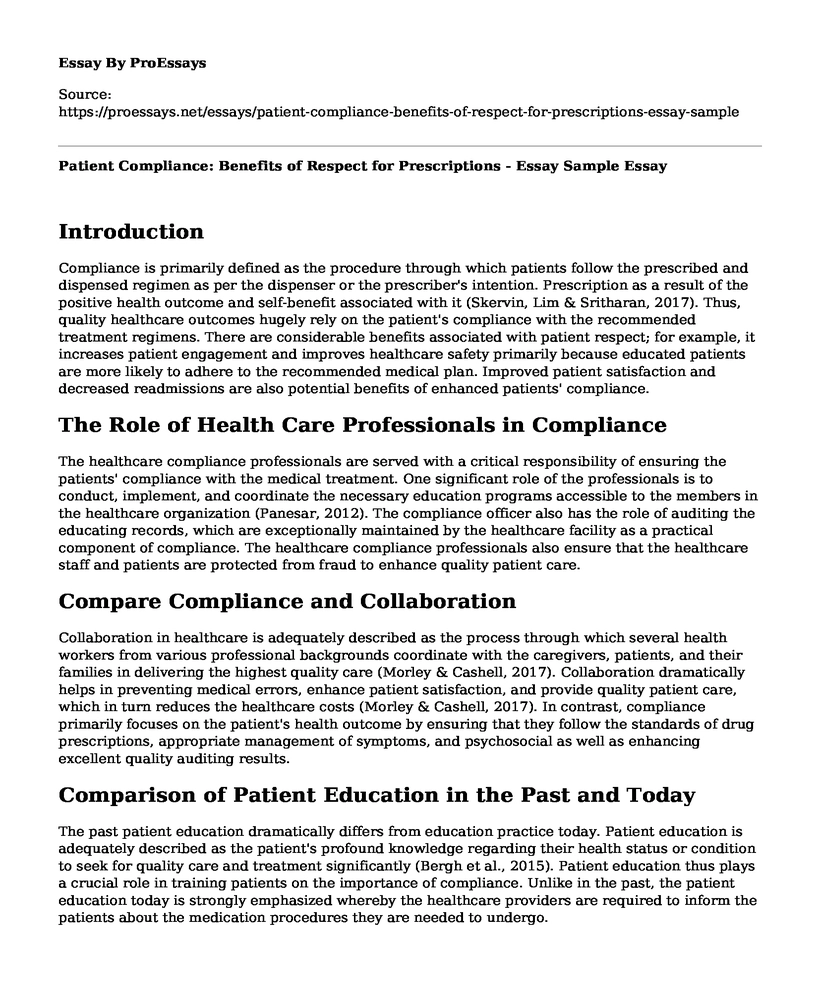Introduction
Compliance is primarily defined as the procedure through which patients follow the prescribed and dispensed regimen as per the dispenser or the prescriber's intention. Prescription as a result of the positive health outcome and self-benefit associated with it (Skervin, Lim & Sritharan, 2017). Thus, quality healthcare outcomes hugely rely on the patient's compliance with the recommended treatment regimens. There are considerable benefits associated with patient respect; for example, it increases patient engagement and improves healthcare safety primarily because educated patients are more likely to adhere to the recommended medical plan. Improved patient satisfaction and decreased readmissions are also potential benefits of enhanced patients' compliance.
The Role of Health Care Professionals in Compliance
The healthcare compliance professionals are served with a critical responsibility of ensuring the patients' compliance with the medical treatment. One significant role of the professionals is to conduct, implement, and coordinate the necessary education programs accessible to the members in the healthcare organization (Panesar, 2012). The compliance officer also has the role of auditing the educating records, which are exceptionally maintained by the healthcare facility as a practical component of compliance. The healthcare compliance professionals also ensure that the healthcare staff and patients are protected from fraud to enhance quality patient care.
Compare Compliance and Collaboration
Collaboration in healthcare is adequately described as the process through which several health workers from various professional backgrounds coordinate with the caregivers, patients, and their families in delivering the highest quality care (Morley & Cashell, 2017). Collaboration dramatically helps in preventing medical errors, enhance patient satisfaction, and provide quality patient care, which in turn reduces the healthcare costs (Morley & Cashell, 2017). In contrast, compliance primarily focuses on the patient's health outcome by ensuring that they follow the standards of drug prescriptions, appropriate management of symptoms, and psychosocial as well as enhancing excellent quality auditing results.
Comparison of Patient Education in the Past and Today
The past patient education dramatically differs from education practice today. Patient education is adequately described as the patient's profound knowledge regarding their health status or condition to seek for quality care and treatment significantly (Bergh et al., 2015). Patient education thus plays a crucial role in training patients on the importance of compliance. Unlike in the past, the patient education today is strongly emphasized whereby the healthcare providers are required to inform the patients about the medication procedures they are needed to undergo.
Importance of Professional Commitment in Patient Education
The commitment of the healthcare professional in educating their patients is of critical significance primarily because they provide the patients with the relevant information to help them make an informed decision concerning their health and also likely to practice improved patient compliance (Richard, Evans & Williams, 2018). Professional commitment is, therefore, the importance of enhancing the patients' preparedness for self-management, knowledge, and understanding.
Three Categories of Learning and How They Are Used in Patient Education
The learning process is significantly divided into three categories, which include psychomotor, cognitive, and effective. Cognitive learning mainly focusing on storing and remembering information, whereas psychomotor happens when a new physical skill is acquired (Bastable, 2017). Affective learning involves the changes that occur in feelings, attitudes, and values.
Problems and Solutions in Patient Education
Patient education is significantly impacted by numerous issues that hiders the provision of quality education. One specific challenge is that most of the professional's lack of adequate training in offering patient education as well as in developing the health education materials for their patients (Richard, Evans & Williams, 2018). Another significant issue is the failure of the patient to implement what they were taught. Language and cultural barriers can also inhibit patient education. Thus a suitable solution to all these challenges is applying the explain back method and educating the patients in layman's terms and utilizing visuals as many times as possible.
Methods of Documentation of Patient Education
Documenting patient education is very important as it ensures professional liability. The documentation should significantly include the specifics subjects that were taught, and some of the patients' responses (Bergh et al., 2015). However, there are various methods of documentation, which include using a standardized form, formal and informal teaching documentation, using charts to record some of the education materials, and updating the teaching plan.
References
Bastable, S. B. (2017). Nurse as educator: Principles of teaching and learning for nursing practice. Jones & Bartlett Learning.
Bergh, A. L., Friberg, F., Persson, E., & Dahlborg-Lyckhage, E. (2015). Registered nurses' patient education in everyday primary care practice: Managers' discourses. Global qualitative nursing research, 2, 2333393615599168.
Morley, L., & Cashell, A. (2017). Collaboration in health care. Journal of medical imaging and radiation sciences, 48(2), 207-216.
Panesar, K. (2012). Patient compliance and health behavior models. US Pharm, 37(4), 12-14.
Richard, E., Evans, T., & Williams, B. (2018). Nursing students' perceptions of preparation to engage in patient education. Nurse education in practice, 28, 1-6.
Skervin, A. L., Lim, C. S., & Sritharan, K. (2017). Improving patient compliance with post-EVAR surveillance may prevent late rupture. Vascular and endovascular surgery, 51(7), 522-526.
Cite this page
Patient Compliance: Benefits of Respect for Prescriptions - Essay Sample. (2023, Apr 11). Retrieved from https://proessays.net/essays/patient-compliance-benefits-of-respect-for-prescriptions-essay-sample
If you are the original author of this essay and no longer wish to have it published on the ProEssays website, please click below to request its removal:
- Evidence-Based Management
- Essay Sample on Nursing Advocacy and Politics
- Teaching Students Who Is Hard of Hearing Paper Example
- Essay Example on Diabetes: Examining Its Impact on Health and Well-Being
- Paper Example on IAD: Causes, Signs, and Prevention of Incontinence-Associated Dermatitis
- Essay Sample on Emergency Departments: A National Stress & Concern
- Essay Example on Vaccination: Key to Disease Prevention & Survival







